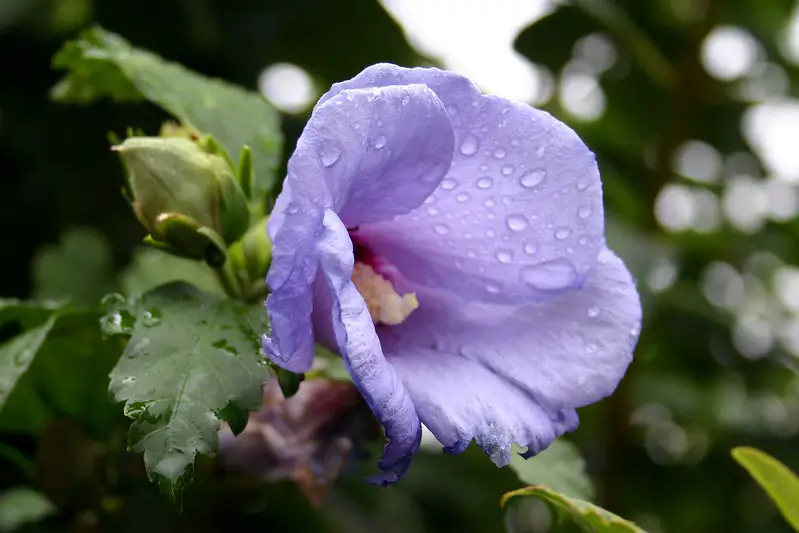Sustainable gardening is becoming more mainstream with each passing year thanks to increased access to information. From environmentally conscious products like natural pesticides to building healthy soil by composting, it’s never been easier to learn how to work alongside Mother Nature.
However, one topic that is often overlooked is the water we use to make our gardens flourish. Tap water is commonly used for watering gardens and while there’s nothing wrong with that, there is another option: harvesting rainwater.

If you’re interested in going the extra mile to harvest rainwater you’ll benefit not only by giving your flowers more nutrients and having access to water in the event of a drought, but you can also lower your water bill and do your small part in helping the planet as well.
Why You Should Use Rainwater for Your Flowers
If you’re like me you want your flower garden to be Instagram-worthy and to accomplish this you already know you need to do everything you can to keep your flowers happy.
If you want to make your life a bit easier you should start incorporating rainwater for the following reasons:
1. Rainwater is Gentle and Natural
Rainwater is naturally “soft” and unlike tap water, it is free of chemicals like chlorine and fluoride. Although small amounts of these chemicals are fine for human consumption, they can be harmful to some plants so it’s best to avoid them in your garden.
2. Rainwater Provides a Boost of Nutrients
While it might seem like plain water, rainwater actually carries a tiny amount of dissolved nitrogen in it. This nitrogen, in the form of nitrates, is readily absorbed by plants and acts as a natural fertilizer, which promotes healthy growth and vibrant blooms.
3. Rainwater Improves Soil Health
Rainwater, unlike tap water, is slightly acidic, which falls within the ideal pH range for most plants (between 5.5 and 6.5). This gentle acidity helps break down essential nutrients locked in the soil, making them more readily available for your flowers to uptake, contributing to their overall health and resilience.
4. Rainwater Saves Precious Water During Dry Periods
As weather patterns continue to shift, droughts are becoming more common. During droughts, many municipalities restrict non-essential water usage to ensure that it’s available for other crucial needs, like drinking and sanitation. By using rainwater in your garden, you can help reduce the strain on your local water supply.
As you can see, using rainwater in your garden isn’t just good for your plans, but it’s also environmentally friendly! And while this all sounds good, you might think that collecting rainwater is difficult, but as you’ll see there are a few ways to do it.
How to Harvest Rainwater for Your Flowers
Rain Barrels
If you want to start small and simple you can begin collecting rainwater with rain barrels, which are exactly what they sound like: barrels that collect rain.
Rain barrels will do the job for most small gardens as they can store anywhere from 50 to 100 gallons of water. Most purpose-built rain barrels come with everything you need to collect water that flows from your roof or, if you prefer to build one yourself, your local hardware store likely has everything you need.
One drawback to smaller rain barrels is that they might overflow in a really bad storm. Not only will you lose the excess water, but the runoff could flood and erode your garden. To avoid this, strategically place your barrel in a good spot, and make sure it’s on a hard surface like paver stones or bricks.
Rainwater Tanks
If you have more space in your garden and a bigger budget you might consider installing rainwater tanks.
Again, rainwater tanks are exactly what they sound like: large tanks that are used to store water for later use.
When purchasing a rainwater tank you will probably need to get it professionally installed and you should definitely make sure there aren’t any restrictions with your municipality or homeowners association if you have one.
Once your tank is installed and filled up you’ll have the peace of mind that you can water your garden any time you need to regardless of drought conditions.
Closing Thoughts
As you can see, incorporating rainwater harvesting into your gardening practices offers a multitude of benefits. You’ll not only be nurturing vibrant blooms and fostering a healthy ecosystem for your plants, but you’ll also be contributing to a more sustainable future.
Start simple with a rain barrel or explore options like larger rainwater tanks to suit your needs and space. With a little planning and effort, you can create a thriving garden while making a positive impact on the environment, one raindrop at a time.
